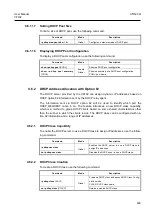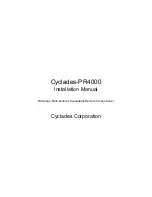
User Manual
UMN:CLI
V8102
391
Command
Mode
Description
spanning-tree
transmit
hold-
count
<1-20>
Global
Sets the number of BPDUs that can be sent before
pausing for 1 second:
1-20: BPDU transmit hold-count value (default:6)
no spanning-tree transmit hold-
count
Deletes a configured transmit hold-count value and
returns to the default setting.
If you change this parameter to a higher value can have a significant impact on CPU utili-
zation, especially in Rapid-PVST mode. We recommend that you maintain the default set-
ting.
9.4.12.6
BPDU Filtering
BPDU filtering allows you to avoid transmitting on the ports that are connected to an end
system. If the BPDU Filter feature is enabled on the port, then incoming BPDUs will be fil-
tered and BPDUs will not be sent out of the port.
To enable or disable the BPDU filtering function on the port, use the following command.
Command
Mode
Description
spanning-tree bpdufilter
enable
Interface
[XE/GE]
Enables a BPDU filtering fuction on specific port.
spanning-tree bpdufilter
disable
Disables a BPDU filtering fuction on specific port.
no spanning-tree bpdufilter
By default, it is disabled. The BPDU filter-enabled port acts as if STP is disabled on the
port. This feature can be used for the ports that are usually connected to an end system
or the port that you don
’t want to receive and send unwanted BPDU packets. Be cautious
about using this feature on STP enabled uplink or trunk port. If the port is removed from
VLAN membership, correspond BPDU filter will be automatically deleted.
To enable or disable the BPDU filtering function on the edge port, use the following com-
mand.
Command
Mode
Description
spanning-tree edgeport bpdufil-
ter
default
Global
Enables a BPDU filtering function by default on all
edge ports.
no
spanning-tree
edgeport
bpdufilter
default
Disables a BPDU filtering function by default on all
edge ports.
9.4.12.7
BPDU Guard
BPDU guard has been designed to allow network designers to enforce the STP domain
borders and keep the active topology predictable. The devices behind the ports with STP
enabled are not allowed to influence the STP topology. This is achieved by disabling the
port upon receipt of BPDU. This feature prevents Denial of Service (DoS) attack on the
network by permanent STP recalculation. That is caused by the temporary introduction
and subsequent removal of STP devices with low (zero) bridge priority.
!
















































